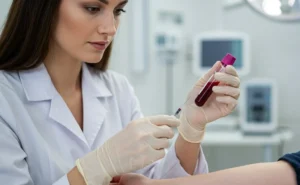Meningitis affects the central nervous system and is common in children and older adults. Experts emphasize that to prevent it, it is important to comply with the vaccination schedule.
The nervous system is housed in bony structures, not directly connected to the bones, the skull, or the spinal column. Instead, it is surrounded by a system of membranous layers called meninges. When a virus or bacteria enters the body and lodges in the nervous organs, inflammation of these membranes occurs; this reaction is called meningitis.
“This is an infectious disease that can be caused by bacteria, viruses, or fungi. When it is caused by bacteria, it causes a more complicated condition in the patient, so it is important to treat it quickly, during the first symptoms, because if not, pus-filled areas form in the meninges, which causes severe inflammation that can cause permanent damage or death,” explains Carlos Grazioso, pediatric infectious disease specialist.
Meningitis presents with several symptoms such as fever, lack of energy, sensitivity to light, stiff neck, headache, and neurological disorders. The last three are the most common.
Eduardo Menéndez, an internal medicine doctor, says that fever is caused because the disease directly affects the periphery of the brain, and body temperature is controlled by the thalamus, which is affected by meningitis.
The headache is caused because the skull is a closed vault and when there is inflammation there is no space for the tissue to expand, since it is inflamed, for that reason, the brain is compressed in its own space, and that causes severe headaches.
Neurological disorders occur because the brain is affected. Some of these disorders include, for example, disorientation, memory disorders, vision disorders, skin or touch perception, as well as seizures, seeing lights, and ringing in the ears.
The diagnosis of the disease is clinical, based on the symptoms presented, and then through laboratory tests that include blood tests and analysis of the cerebrospinal fluid, which circulates in the brain and spinal column.
Diagnosis is eventually supported by brain imaging studies, such as magnetic resonance imaging.
Causes
Most cases of meningitis are caused by bacteria or viruses. Many of these are fairly common and also cause other common illnesses. Both types, bacterial and viral, are spread like most other infections: an infected person touches, kisses, coughs, or sneezes on someone who is not infected.
Bacterial meningitis is less common, but it is usually serious when it occurs. It can also be life-threatening if not treated immediately. In some cases, the bacteria reach the meninges after a severe head injury, that is, a strong blow to the head, or a serious local infection, such as an ear or sinus infection (sinusitis).
Viral meningitis, also called aseptic meningitis, is more common and is usually less severe. Many of the viruses that cause it are common, such as those that cause colds, diarrhea, cold sores, and the flu.
Risk factors
This disease is common at the extremes of life. That is, in newborns, in children, especially at two years of age, or in the elderly. Although there are also cases in adults, says Víctor Arévalo, a neurologist.

Children are more likely to suffer from meningitis when they have repeated infections, such as ear infections, anatomical abnormalities, or lack a complete vaccination schedule, or even when they have not been vaccinated.
Adults are at risk when they have chronic diseases because they already have a “compromised immune system,” such as diabetics. Also, those who frequently consume alcohol, or those who have suffered head injuries, sinusitis, otitis, or pneumonia.
How to prevent it
Specialists say that the best way to prevent meningitis in children is to give them all the vaccines established in the Guatemalan vaccination system since it is quite complete and contains some that prevent bacteria such as Haemophilus influenzae type B and Streptococcus pneumoniae or pneumococcus.
“Neisseria meningitidis is a fairly rare bacteria, but when it appears it can cause very aggressive damage. It can cause alterations in the circulation of the extremities, and sometimes they even have to be amputated. There is a vaccine that can prevent it, but since it is a very rare bacteria, its price is high. It is not included in the national vaccination system, but we hope that one day it will be included,” says Grazioso.
Arévalo also recommends maintaining good hygiene measures such as washing your hands constantly, keeping your glucose levels under control, and treating ear infections, sinusitis, or pneumonia immediately and correctly. In addition, wearing a helmet when riding a motorcycle to avoid any head injuries.
Vaccination schedule
Vaccines are used to strengthen the immune system and thus prevent diseases, so it is advisable to keep the vaccination schedule up to date so that all of them perform their function correctly. The age at which they are administered will vary for each person.
TDaP vaccine: Protects against maternal and neonatal diphtheria, tetanus, and whooping cough. A single dose is administered starting at 5 months of pregnancy. It should be administered during each pregnancy.
Hepatitis A: The only dose required is given at one year and three months of age.
Hepatitis B: It is given to the newborn and a single dose is taken.
BCG vaccine: Prevents tuberculosis in its most serious forms and is given to newborns.
Polio and Pentavalent: the first prevents polio, paralysis, and physical disability, while the second prevents five diseases: diphtheria, tetanus, whooping cough, hepatitis B, and meningitis. The first dose of both is given at the first two months of life, the second dose at 4 months, and the third at 6. Polio requires a booster at 18 months and 4 years.
Rotavirus: Prevents serious infections and complications caused by diarrhea or dehydration caused by rotavirus. The first dose is given at 2 months of age and the second at 4 months of age.
Pneumococcus: Protects against pneumonia, otitis media, and other serious or invasive infections caused by Streptococcus pneumoniae. The first dose is administered at 2 months of age and the second at 4 months of age. A booster is required at one year of age. In older adults, two doses are administered, the second six months after the first.
DPT vaccine: Prevents diphtheria, tetanus, and whooping cough. One dose is given at five months of pregnancy, then a booster is given when the baby is 18 months old and at four years old.
MMR vaccine: Prevents measles, mumps and rubella. The first dose is administered at 1 year of age and the second dose at 18 months of age.
HPV vaccine: Prevents cervical cancer. It can be administered at age 9 and a second dose 6 months after the first. If you are over 15, three doses are required: the second one a month after the first and the third five months after the second.
Influenza: The first dose is given starting at six months of age and the second at seven months of age. For older adults, one dose per year is recommended.
Varicella: Prevents chickenpox and its complications. The only dose is administered one and a half years after birth.























+ There are no comments
Add yours